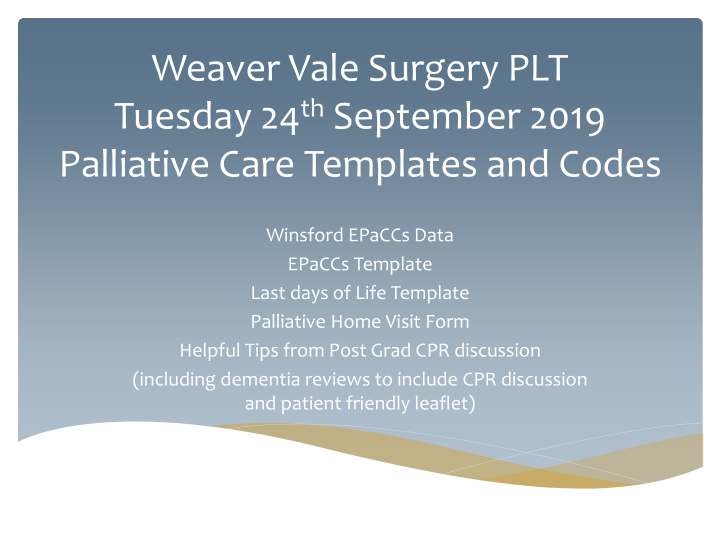



Weaver Vale Surgery PLT Tuesday 24 th September 2019 Palliative Care Templates and Codes Winsford EPaCCs Data EPaCCs Template Last days of Life Template Palliative Home Visit Form Helpful Tips from Post Grad CPR discussion (including dementia reviews to include CPR discussion and patient friendly leaflet)
Winsford EPaCCs Data Qtrs 3&4 Oct-March 2018-19
Palliative Care Co-ordination EPaCCs Template
Essential Codes Page 1 Consent to Share Page 1 On GSF register Page 1 Notification of palliative care plan in place to OOH Page 1 Ambulance service notified NWAS Page 2 Diagnosis (type it in) Page 5 Advanced Care Planning Page 5 Preferred Preferences of care AND death Page 5 Resuscitation discussion Page 6 Prescription of palliative care anticipatory meds Page 6 Notification of anticipated death to OOH Page 7 Date and place of death
Quality Improvement Codes Page 1 DS1500 Page 4 Patient has a Carer Page 4 Details of Main carer Page 4 NOK
EPaCCs Summary View in EMIS
Last Days of Life Template The template has been created by local GPs , District Nurses and Specialist Palliative Care Teams in response to locally identified needs for best managing people in their last hours / days of life: To save time, reduce bureaucracy and duplication To provide “accountable and defensible” documentation to support last days of life decision making To coordinate last days of life care across services without the need for lengthy paperwork To share key information electronically using read codes already being used for palliative and end of life care i.e. within EPaCCS The template should be used: For when the GP/Team has discussed and agreed that their condition is deteriorating, and death is likely within hours or small number of days If the patient IS for CPR – this template is not appropriate Link to cheshire-epaige re 5 Priorities of Care Section for end of life meds in place, containing algorithms and guidance for doses/pain/nausea/ breathlessness etc
Palliative Home Visit Form Of any value/help with criteria required?
DNAR presentation at Post Grad Information to share Discharge summary/letters that contain the words ‘ AMBER discussions ’, mean that advanced care planning discussions have taken place with the patient and/or family. Good practice for GP to follow up with the family to check if DNAR has been put in place and does the patient/family understand what this means and are happy for it to stand. Document that you have had the discussion in your consultation.
Patients discharged with a DNAR in place – make sure you task admin to upload the information to OOH via special note form and inform NWAS via ERISS system Discharge states “ please consider adding to the GSF register ”. This means the consultant is unsure whether the patient will have a good outcome or will deteriorate, they are asking for the GP to assess and discuss with the patient/family and make that decision
Dementia annual review – As this is a progressive disease, the plans and reviews section of the WV Dementia template, has been edited to include ‘discussion about CPR’. You should emphasise the fact that this is NOT withdrawal of treatment, you will still get admitted, you will still receive pain relief – it is simply explaining, what do I want to happen if my heart stops. Document in consultation (via dementia template), that you have had the discussion and given patient friendly CPR leaflet
RECAP USE the EPaCCs template to ensure accurate coding and sharing of EOL information Use the End of Life template when death expected within last few days/week Document all discussions re CPR, including dementia – utilise the patient friendly CPR leaflet Palliative Home Visit Form – do you want to use it?
Recommend
More recommend